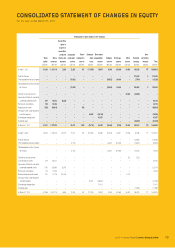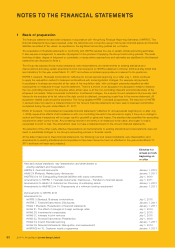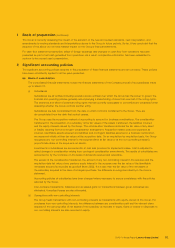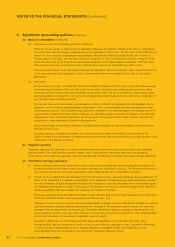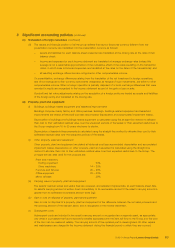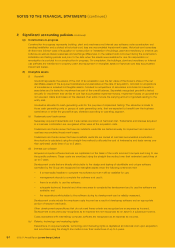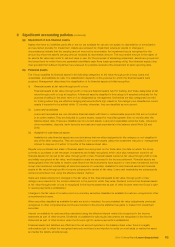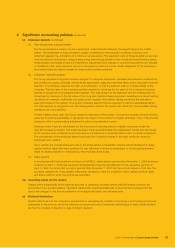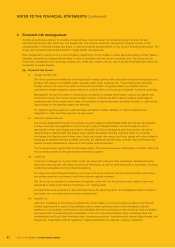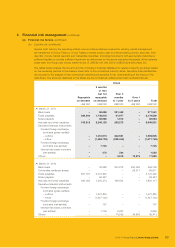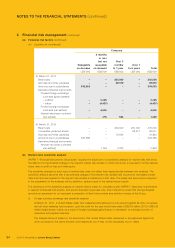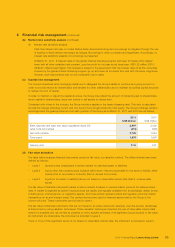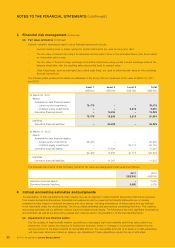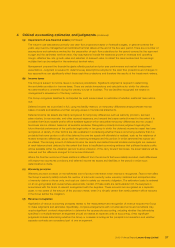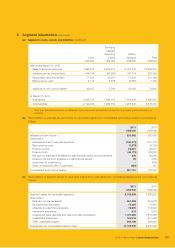Lenovo 2011 Annual Report Download - page 86
Download and view the complete annual report
Please find page 86 of the 2011 Lenovo annual report below. You can navigate through the pages in the report by either clicking on the pages listed below, or by using the keyword search tool below to find specific information within the annual report.
2010/11 Annual Report Lenovo Group Limited 89
2 Significant accounting policies (continued)
(q) Provisions (continued)
(ii) Other provisions
Provisions for environmental restoration, restructuring costs and legal claims are recognized when: the Group has
a present legal or constructive obligation as a result of past events; it is probable that an outflow of resources will
be required to settle the obligation; and the amount has been reliably estimated. Restructuring costs provision
comprises lease termination penalties and employee termination payments. Provisions are not recognized for future
operating losses.
(r) Current and deferred income tax
The tax expense for the period comprises current and deferred income tax.
The current income tax charge is calculated on the basis of the tax laws enacted or substantively enacted at the
balance sheet date in the countries where the Company’s subsidiaries and associates operate and generate taxable
income. Management periodically evaluates positions taken in tax returns with respect to situations in which applicable
tax regulation is subject to interpretation. It establishes provisions where appropriate on the basis of amounts expected
to be paid to the tax authorities.
Deferred income tax is recognized, using the liability method, on temporary differences arising between the tax bases
of assets and liabilities and their carrying amounts in the financial statements. However, deferred income tax is not
accounted for if it arises from initial recognition of an asset or liability in a transaction other than a business combination
that at the time of the transaction affects neither accounting nor taxable profit or loss. Deferred income tax is determined
using tax rates (and laws) that have been enacted or substantively enacted by the balance sheet date and are expected
to apply when the related deferred income tax asset is realized or the deferred income tax liability is settled.
Deferred income tax assets are recognized to the extent that it is probable that future taxable profit will be available
against which the temporary differences can be utilized.
Deferred income tax is provided on temporary differences arising on investments in subsidiaries and associates, except
for deferred income tax liability where the timing of the reversal of the temporary difference is controlled by the Group
and it is probable that the temporary difference will not reverse in the foreseeable future.
Deferred income tax assets and liabilities are offset when there is a legally enforceable right to offset current tax assets
against current tax liabilities and when the deferred income tax assets and liabilities relate to income taxes levied by
the same tax authority on either the taxable entity or different taxable entities where there is an intention to settle the
balances on a net basis.
(s) Contingent liabilities
A contingent liability is a possible obligation that arises from past events and whose existence will only be confirmed by
the occurrence or non-occurrence of one or more uncertain future events not wholly within the control of the Group. It
can also be a present obligation arising from past events that is not recognized because it is not probable that outflow
of economic resources will be required or the amount of obligation cannot be measured reliably.
A contingent liability is not recognized but is disclosed in the notes to the financial statements. When a change in the
probability of an outflow occurs so that the outflow is probable, it will then be recognized as a provision.
(t) Revenue
Revenue is measured at the fair value of the consideration received or receivable for the sale of goods and services in
the normal course of the Group’s activities.
(i) Sale of goods and services
Revenue from sale of hardware, software and peripherals, services and mobile devices is recognized, net of
value-added tax, an allowance for estimated returns, rebates and discounts, when both ownership and risk of
loss are effectively transferred to customer, generally when there is a persuasive evidence of a sales arrangement
exists, the price is fixed or determinable, collectability is reasonably assured and delivery has occurred. Revenue
from extended warranty contracts is deferred and amortized as earned over the contract period, ranging from
one to four years. Revenue associated with undelivered elements is deferred and recorded when delivery occurs.
Revenue from provision of systems integration service and information technology technical service is recognized
over the term of contract or when services are rendered.
The Group defers the cost of shipped products awaiting revenue recognition until the goods are delivered and
revenue is recognized. In-transit product shipments to customers of US$236 million as at March 31, 2011 (2010:
US$48 million) are included in deposits, prepayments and other receivables in the balance sheet.


